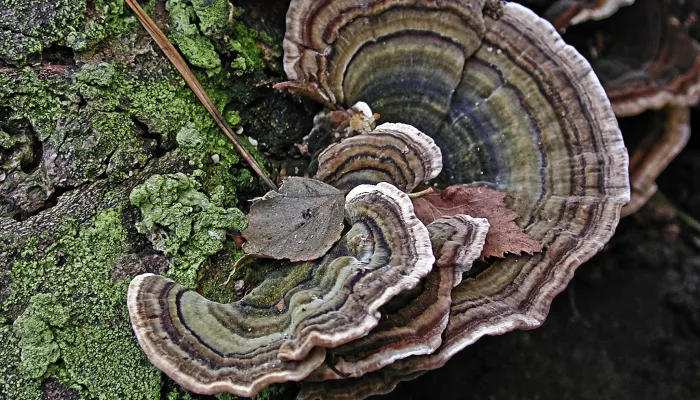| Statistics | |
|---|---|
| Cap diameter: | 4cm - 10cm |
The turkeytail is a very colourful bracket fungus that grows throughout the year, but is at its best in the autumn. Its circular caps can be seen growing in tiers on trees and dead wood.
About
The turkeytail is a small, tough, bracket fungus that grows in tiered layers on dead wood - mainly hardwood, such as beech or oak. It is very common and can be found throughout the UK on rotting stumps and branches. Fungi belong to their own kingdom and get their nutrients and energy from organic matter, rather than photosynthesis like plants. It is often just the fruiting bodies, or 'mushrooms', that are visible to us, arising from an unseen network of tiny filaments called 'hyphae'. These fruiting bodies produce spores for reproduction, although fungi can also reproduce asexually by fragmentation.
How to identify
The turkeytail is a bracket fungus that forms semi-circular caps around tree trunks. The caps are thin and tough, with very clear, velvety, concentric rings of colour. Colours are variable mixes of brown, yellow, grey, purple, green and black, but the outer margin is always pale - either cream or white. The caps are often layered together, forming tiers.
Did you know?
The turkeytail is a very colourful fungus and was once popular as a table decoration; at one time, it was even used to decorate hats!
How people can help
Fungi play an important role within our ecosystems, helping to recycle nutrients from dead or decaying organic matter, and providing food and shelter for different animals. The Wildlife Trusts manage many nature reserves sympathetically for the benefit of all kinds of wildlife, including fungi: you can help by supporting your local Trust and becoming a member. Our gardens are also a vital resource for wildlife, providing corridors of green space between open countryside. Try leaving log piles and dead wood to help fungi and the wildlife that depends on it. To find out more about encouraging wildlife into your garden, visit our Wild About Gardens website: a joint initiative with the RHS.

